A Comprehensive Report on Disability Discrimination in Society
VerifiedAdded on 2023/06/03
|6
|1663
|55
Report
AI Summary
This report delves into the persistent issue of disability discrimination across various societal contexts, examining its historical roots, contemporary manifestations, and potential solutions. It highlights the diverse definitions of disability, the historical instances of discrimination, and the ongoing challenges faced by individuals with disabilities in education and the workplace. The research questions focus on the reasons behind the persistence of discrimination, strategies for its reduction, methods for consoling victims, and policies for ensuring equal rights and opportunities. Employing a primary research methodology, the study gathers data through interviews and questionnaires, utilizing both qualitative and quantitative analysis techniques to provide a comprehensive understanding of the issue. The discussion and conclusion sections explore the relationships between research findings, offering a basis for recommendations and identifying areas for future research. The report references a range of scholarly articles and reports to support its analysis and findings.
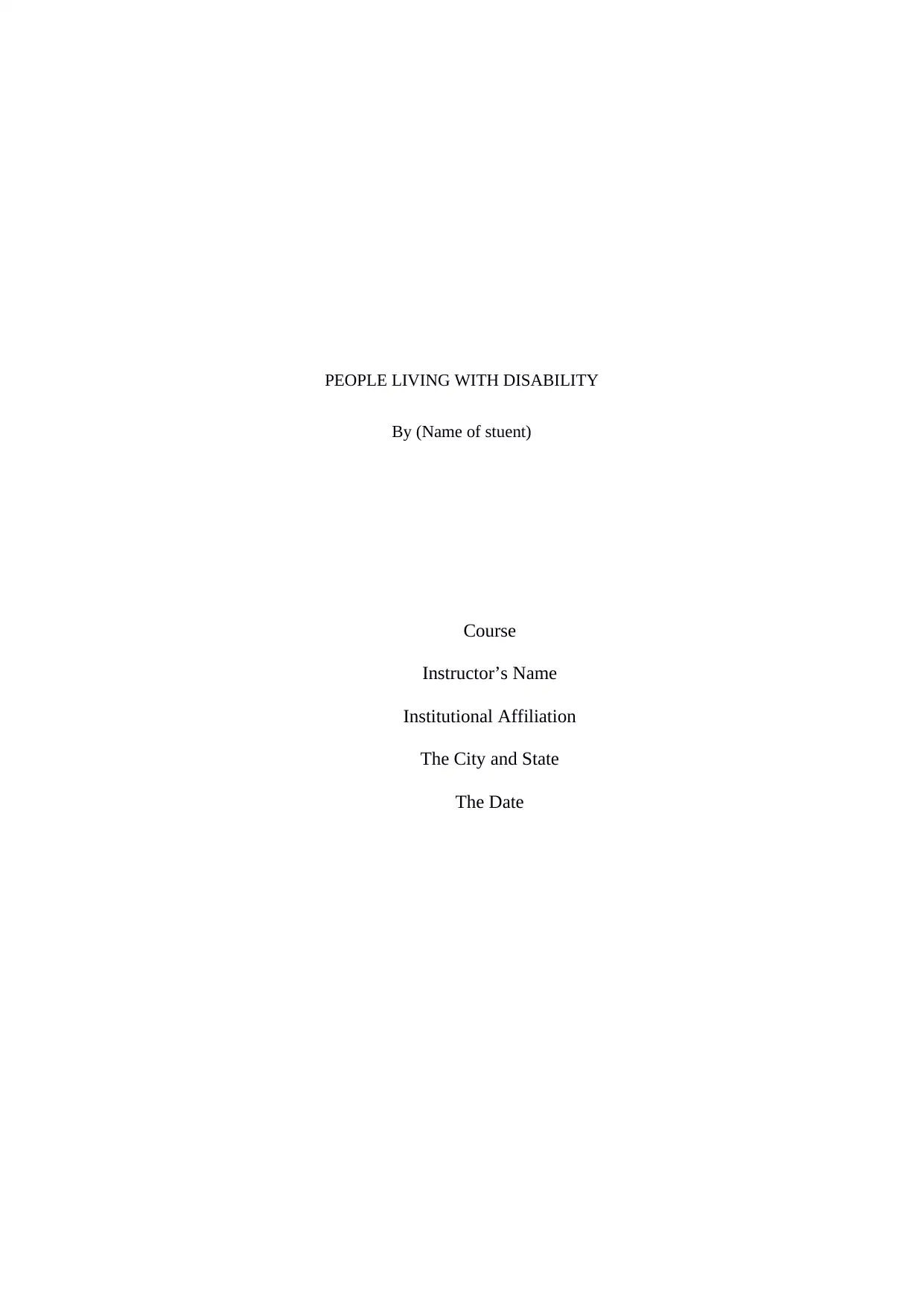
PEOPLE LIVING WITH DISABILITY
By (Name of stuent)
Course
Instructor’s Name
Institutional Affiliation
The City and State
The Date
By (Name of stuent)
Course
Instructor’s Name
Institutional Affiliation
The City and State
The Date
Paraphrase This Document
Need a fresh take? Get an instant paraphrase of this document with our AI Paraphraser
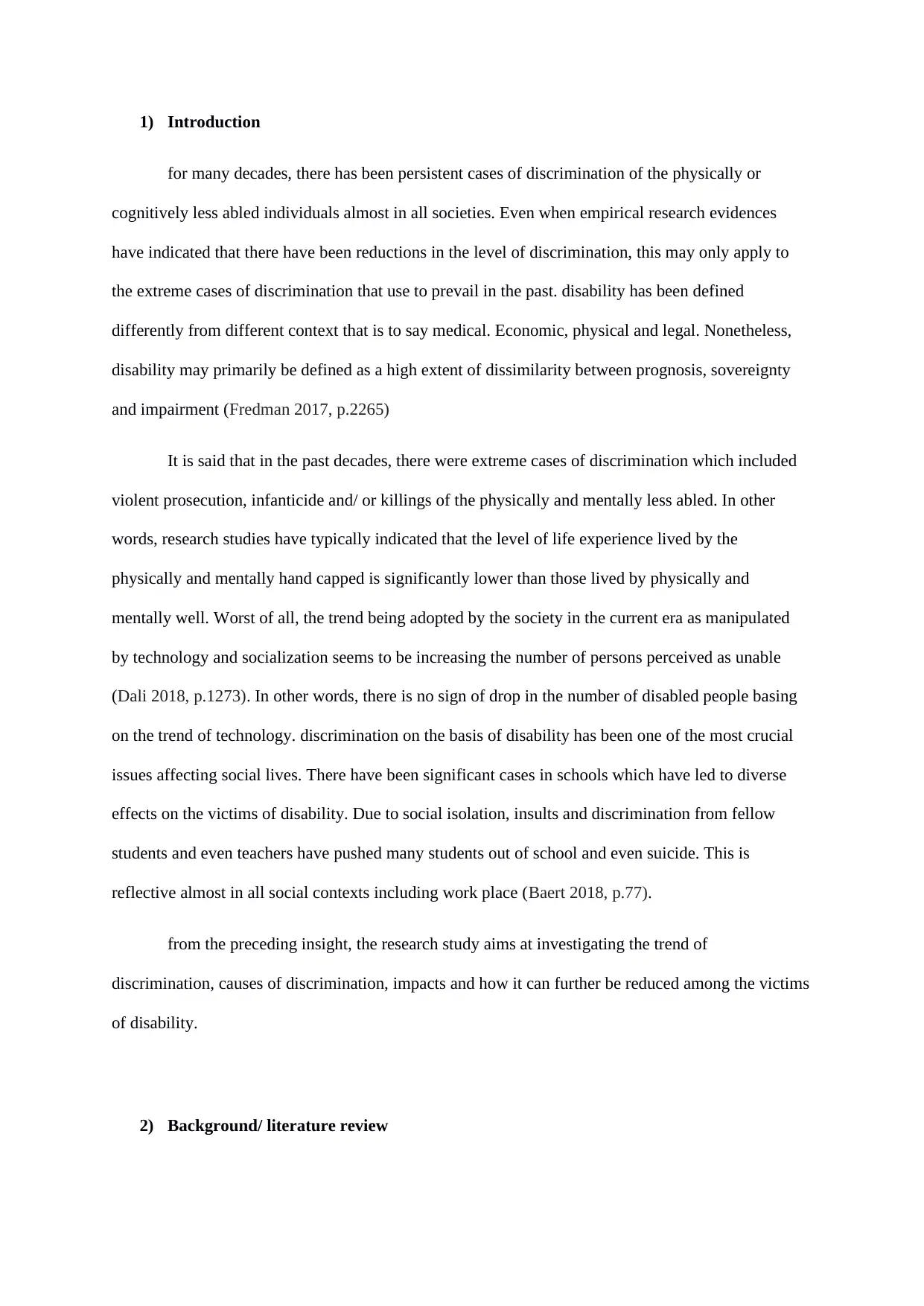
1) Introduction
for many decades, there has been persistent cases of discrimination of the physically or
cognitively less abled individuals almost in all societies. Even when empirical research evidences
have indicated that there have been reductions in the level of discrimination, this may only apply to
the extreme cases of discrimination that use to prevail in the past. disability has been defined
differently from different context that is to say medical. Economic, physical and legal. Nonetheless,
disability may primarily be defined as a high extent of dissimilarity between prognosis, sovereignty
and impairment (Fredman 2017, p.2265)
It is said that in the past decades, there were extreme cases of discrimination which included
violent prosecution, infanticide and/ or killings of the physically and mentally less abled. In other
words, research studies have typically indicated that the level of life experience lived by the
physically and mentally hand capped is significantly lower than those lived by physically and
mentally well. Worst of all, the trend being adopted by the society in the current era as manipulated
by technology and socialization seems to be increasing the number of persons perceived as unable
(Dali 2018, p.1273). In other words, there is no sign of drop in the number of disabled people basing
on the trend of technology. discrimination on the basis of disability has been one of the most crucial
issues affecting social lives. There have been significant cases in schools which have led to diverse
effects on the victims of disability. Due to social isolation, insults and discrimination from fellow
students and even teachers have pushed many students out of school and even suicide. This is
reflective almost in all social contexts including work place (Baert 2018, p.77).
from the preceding insight, the research study aims at investigating the trend of
discrimination, causes of discrimination, impacts and how it can further be reduced among the victims
of disability.
2) Background/ literature review
for many decades, there has been persistent cases of discrimination of the physically or
cognitively less abled individuals almost in all societies. Even when empirical research evidences
have indicated that there have been reductions in the level of discrimination, this may only apply to
the extreme cases of discrimination that use to prevail in the past. disability has been defined
differently from different context that is to say medical. Economic, physical and legal. Nonetheless,
disability may primarily be defined as a high extent of dissimilarity between prognosis, sovereignty
and impairment (Fredman 2017, p.2265)
It is said that in the past decades, there were extreme cases of discrimination which included
violent prosecution, infanticide and/ or killings of the physically and mentally less abled. In other
words, research studies have typically indicated that the level of life experience lived by the
physically and mentally hand capped is significantly lower than those lived by physically and
mentally well. Worst of all, the trend being adopted by the society in the current era as manipulated
by technology and socialization seems to be increasing the number of persons perceived as unable
(Dali 2018, p.1273). In other words, there is no sign of drop in the number of disabled people basing
on the trend of technology. discrimination on the basis of disability has been one of the most crucial
issues affecting social lives. There have been significant cases in schools which have led to diverse
effects on the victims of disability. Due to social isolation, insults and discrimination from fellow
students and even teachers have pushed many students out of school and even suicide. This is
reflective almost in all social contexts including work place (Baert 2018, p.77).
from the preceding insight, the research study aims at investigating the trend of
discrimination, causes of discrimination, impacts and how it can further be reduced among the victims
of disability.
2) Background/ literature review
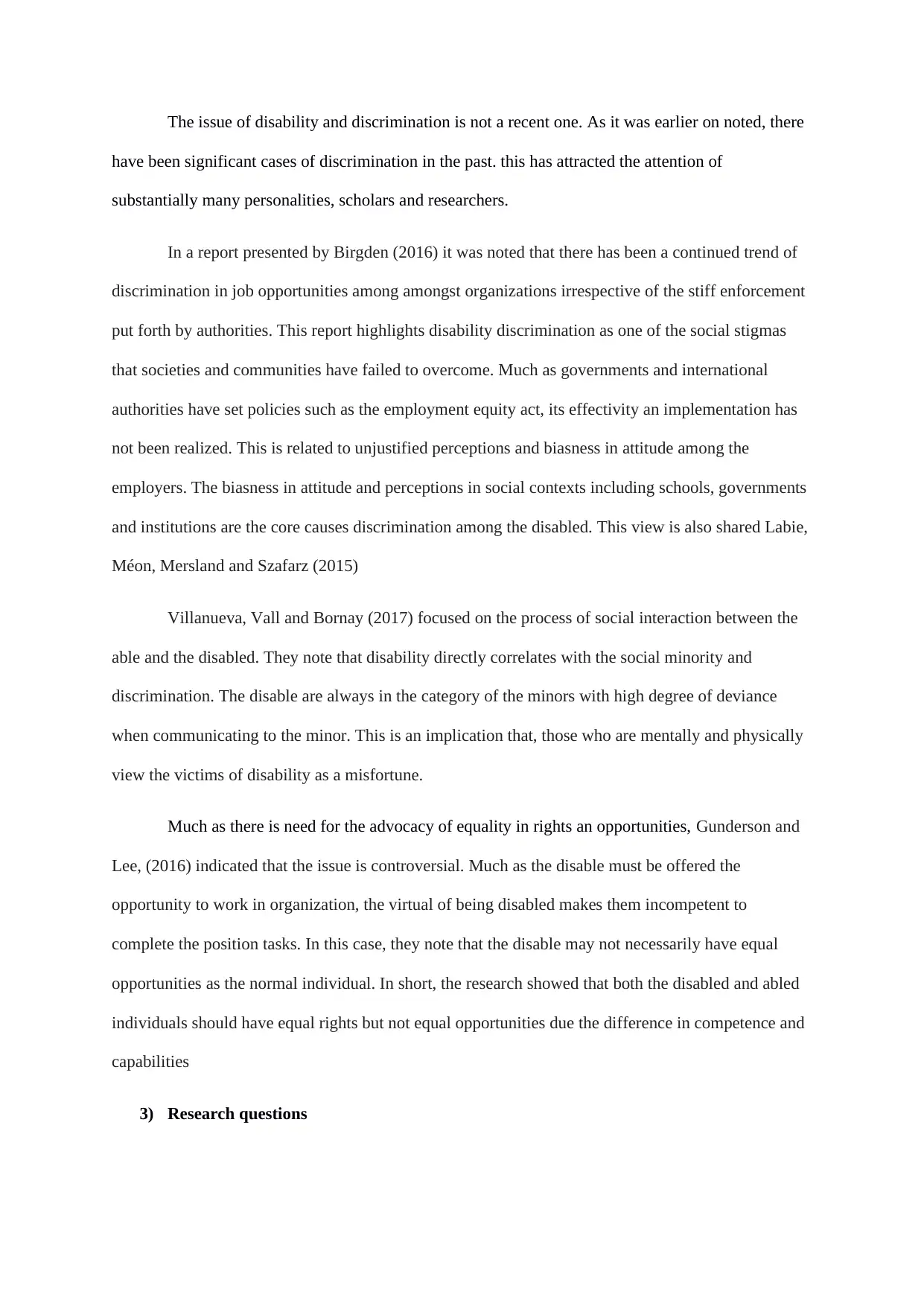
The issue of disability and discrimination is not a recent one. As it was earlier on noted, there
have been significant cases of discrimination in the past. this has attracted the attention of
substantially many personalities, scholars and researchers.
In a report presented by Birgden (2016) it was noted that there has been a continued trend of
discrimination in job opportunities among amongst organizations irrespective of the stiff enforcement
put forth by authorities. This report highlights disability discrimination as one of the social stigmas
that societies and communities have failed to overcome. Much as governments and international
authorities have set policies such as the employment equity act, its effectivity an implementation has
not been realized. This is related to unjustified perceptions and biasness in attitude among the
employers. The biasness in attitude and perceptions in social contexts including schools, governments
and institutions are the core causes discrimination among the disabled. This view is also shared Labie,
Méon, Mersland and Szafarz (2015)
Villanueva, Vall and Bornay (2017) focused on the process of social interaction between the
able and the disabled. They note that disability directly correlates with the social minority and
discrimination. The disable are always in the category of the minors with high degree of deviance
when communicating to the minor. This is an implication that, those who are mentally and physically
view the victims of disability as a misfortune.
Much as there is need for the advocacy of equality in rights an opportunities, Gunderson and
Lee, (2016) indicated that the issue is controversial. Much as the disable must be offered the
opportunity to work in organization, the virtual of being disabled makes them incompetent to
complete the position tasks. In this case, they note that the disable may not necessarily have equal
opportunities as the normal individual. In short, the research showed that both the disabled and abled
individuals should have equal rights but not equal opportunities due the difference in competence and
capabilities
3) Research questions
have been significant cases of discrimination in the past. this has attracted the attention of
substantially many personalities, scholars and researchers.
In a report presented by Birgden (2016) it was noted that there has been a continued trend of
discrimination in job opportunities among amongst organizations irrespective of the stiff enforcement
put forth by authorities. This report highlights disability discrimination as one of the social stigmas
that societies and communities have failed to overcome. Much as governments and international
authorities have set policies such as the employment equity act, its effectivity an implementation has
not been realized. This is related to unjustified perceptions and biasness in attitude among the
employers. The biasness in attitude and perceptions in social contexts including schools, governments
and institutions are the core causes discrimination among the disabled. This view is also shared Labie,
Méon, Mersland and Szafarz (2015)
Villanueva, Vall and Bornay (2017) focused on the process of social interaction between the
able and the disabled. They note that disability directly correlates with the social minority and
discrimination. The disable are always in the category of the minors with high degree of deviance
when communicating to the minor. This is an implication that, those who are mentally and physically
view the victims of disability as a misfortune.
Much as there is need for the advocacy of equality in rights an opportunities, Gunderson and
Lee, (2016) indicated that the issue is controversial. Much as the disable must be offered the
opportunity to work in organization, the virtual of being disabled makes them incompetent to
complete the position tasks. In this case, they note that the disable may not necessarily have equal
opportunities as the normal individual. In short, the research showed that both the disabled and abled
individuals should have equal rights but not equal opportunities due the difference in competence and
capabilities
3) Research questions
⊘ This is a preview!⊘
Do you want full access?
Subscribe today to unlock all pages.

Trusted by 1+ million students worldwide
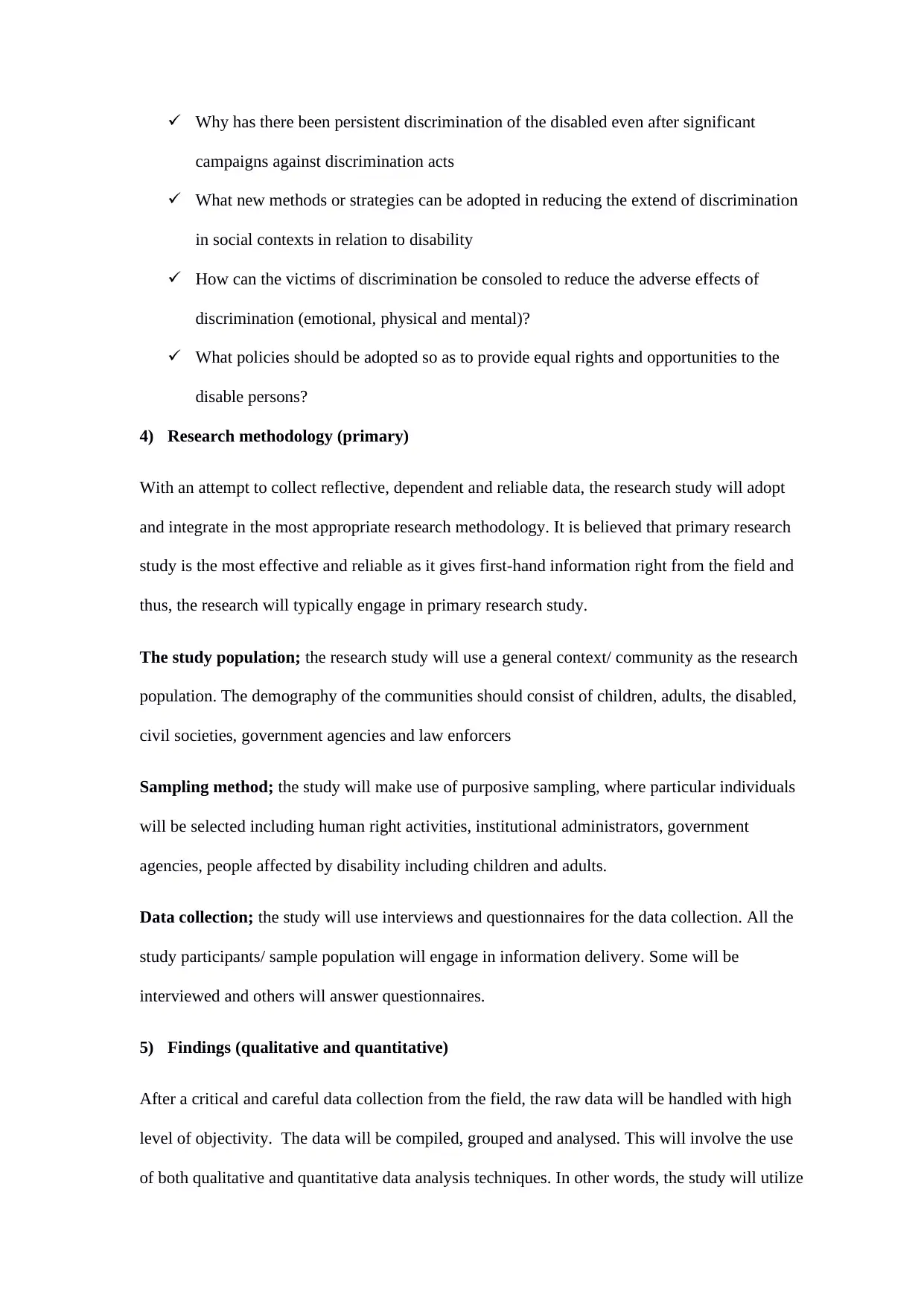
Why has there been persistent discrimination of the disabled even after significant
campaigns against discrimination acts
What new methods or strategies can be adopted in reducing the extend of discrimination
in social contexts in relation to disability
How can the victims of discrimination be consoled to reduce the adverse effects of
discrimination (emotional, physical and mental)?
What policies should be adopted so as to provide equal rights and opportunities to the
disable persons?
4) Research methodology (primary)
With an attempt to collect reflective, dependent and reliable data, the research study will adopt
and integrate in the most appropriate research methodology. It is believed that primary research
study is the most effective and reliable as it gives first-hand information right from the field and
thus, the research will typically engage in primary research study.
The study population; the research study will use a general context/ community as the research
population. The demography of the communities should consist of children, adults, the disabled,
civil societies, government agencies and law enforcers
Sampling method; the study will make use of purposive sampling, where particular individuals
will be selected including human right activities, institutional administrators, government
agencies, people affected by disability including children and adults.
Data collection; the study will use interviews and questionnaires for the data collection. All the
study participants/ sample population will engage in information delivery. Some will be
interviewed and others will answer questionnaires.
5) Findings (qualitative and quantitative)
After a critical and careful data collection from the field, the raw data will be handled with high
level of objectivity. The data will be compiled, grouped and analysed. This will involve the use
of both qualitative and quantitative data analysis techniques. In other words, the study will utilize
campaigns against discrimination acts
What new methods or strategies can be adopted in reducing the extend of discrimination
in social contexts in relation to disability
How can the victims of discrimination be consoled to reduce the adverse effects of
discrimination (emotional, physical and mental)?
What policies should be adopted so as to provide equal rights and opportunities to the
disable persons?
4) Research methodology (primary)
With an attempt to collect reflective, dependent and reliable data, the research study will adopt
and integrate in the most appropriate research methodology. It is believed that primary research
study is the most effective and reliable as it gives first-hand information right from the field and
thus, the research will typically engage in primary research study.
The study population; the research study will use a general context/ community as the research
population. The demography of the communities should consist of children, adults, the disabled,
civil societies, government agencies and law enforcers
Sampling method; the study will make use of purposive sampling, where particular individuals
will be selected including human right activities, institutional administrators, government
agencies, people affected by disability including children and adults.
Data collection; the study will use interviews and questionnaires for the data collection. All the
study participants/ sample population will engage in information delivery. Some will be
interviewed and others will answer questionnaires.
5) Findings (qualitative and quantitative)
After a critical and careful data collection from the field, the raw data will be handled with high
level of objectivity. The data will be compiled, grouped and analysed. This will involve the use
of both qualitative and quantitative data analysis techniques. In other words, the study will utilize
Paraphrase This Document
Need a fresh take? Get an instant paraphrase of this document with our AI Paraphraser
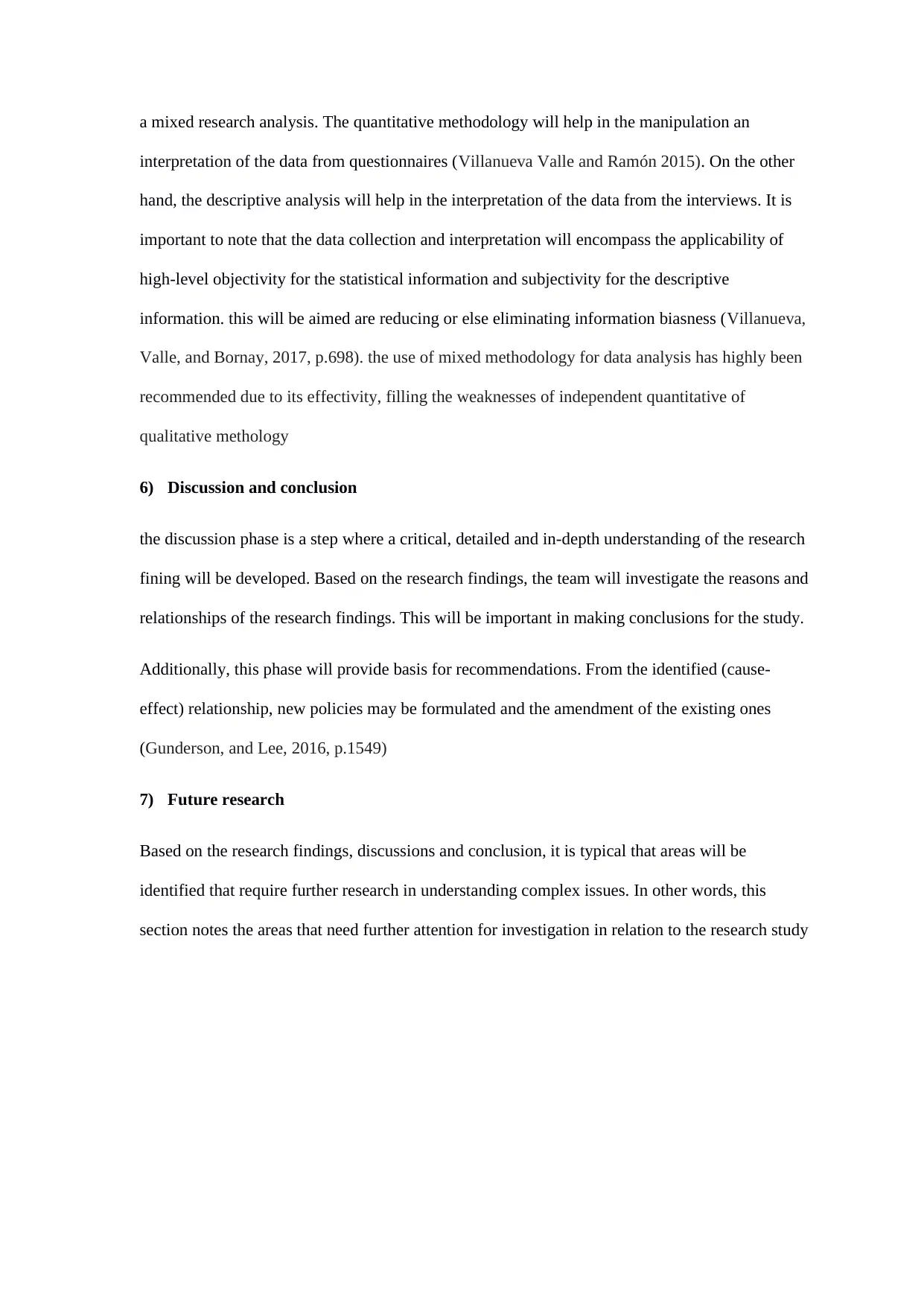
a mixed research analysis. The quantitative methodology will help in the manipulation an
interpretation of the data from questionnaires (Villanueva Valle and Ramón 2015). On the other
hand, the descriptive analysis will help in the interpretation of the data from the interviews. It is
important to note that the data collection and interpretation will encompass the applicability of
high-level objectivity for the statistical information and subjectivity for the descriptive
information. this will be aimed are reducing or else eliminating information biasness (Villanueva,
Valle, and Bornay, 2017, p.698). the use of mixed methodology for data analysis has highly been
recommended due to its effectivity, filling the weaknesses of independent quantitative of
qualitative methology
6) Discussion and conclusion
the discussion phase is a step where a critical, detailed and in-depth understanding of the research
fining will be developed. Based on the research findings, the team will investigate the reasons and
relationships of the research findings. This will be important in making conclusions for the study.
Additionally, this phase will provide basis for recommendations. From the identified (cause-
effect) relationship, new policies may be formulated and the amendment of the existing ones
(Gunderson, and Lee, 2016, p.1549)
7) Future research
Based on the research findings, discussions and conclusion, it is typical that areas will be
identified that require further research in understanding complex issues. In other words, this
section notes the areas that need further attention for investigation in relation to the research study
interpretation of the data from questionnaires (Villanueva Valle and Ramón 2015). On the other
hand, the descriptive analysis will help in the interpretation of the data from the interviews. It is
important to note that the data collection and interpretation will encompass the applicability of
high-level objectivity for the statistical information and subjectivity for the descriptive
information. this will be aimed are reducing or else eliminating information biasness (Villanueva,
Valle, and Bornay, 2017, p.698). the use of mixed methodology for data analysis has highly been
recommended due to its effectivity, filling the weaknesses of independent quantitative of
qualitative methology
6) Discussion and conclusion
the discussion phase is a step where a critical, detailed and in-depth understanding of the research
fining will be developed. Based on the research findings, the team will investigate the reasons and
relationships of the research findings. This will be important in making conclusions for the study.
Additionally, this phase will provide basis for recommendations. From the identified (cause-
effect) relationship, new policies may be formulated and the amendment of the existing ones
(Gunderson, and Lee, 2016, p.1549)
7) Future research
Based on the research findings, discussions and conclusion, it is typical that areas will be
identified that require further research in understanding complex issues. In other words, this
section notes the areas that need further attention for investigation in relation to the research study
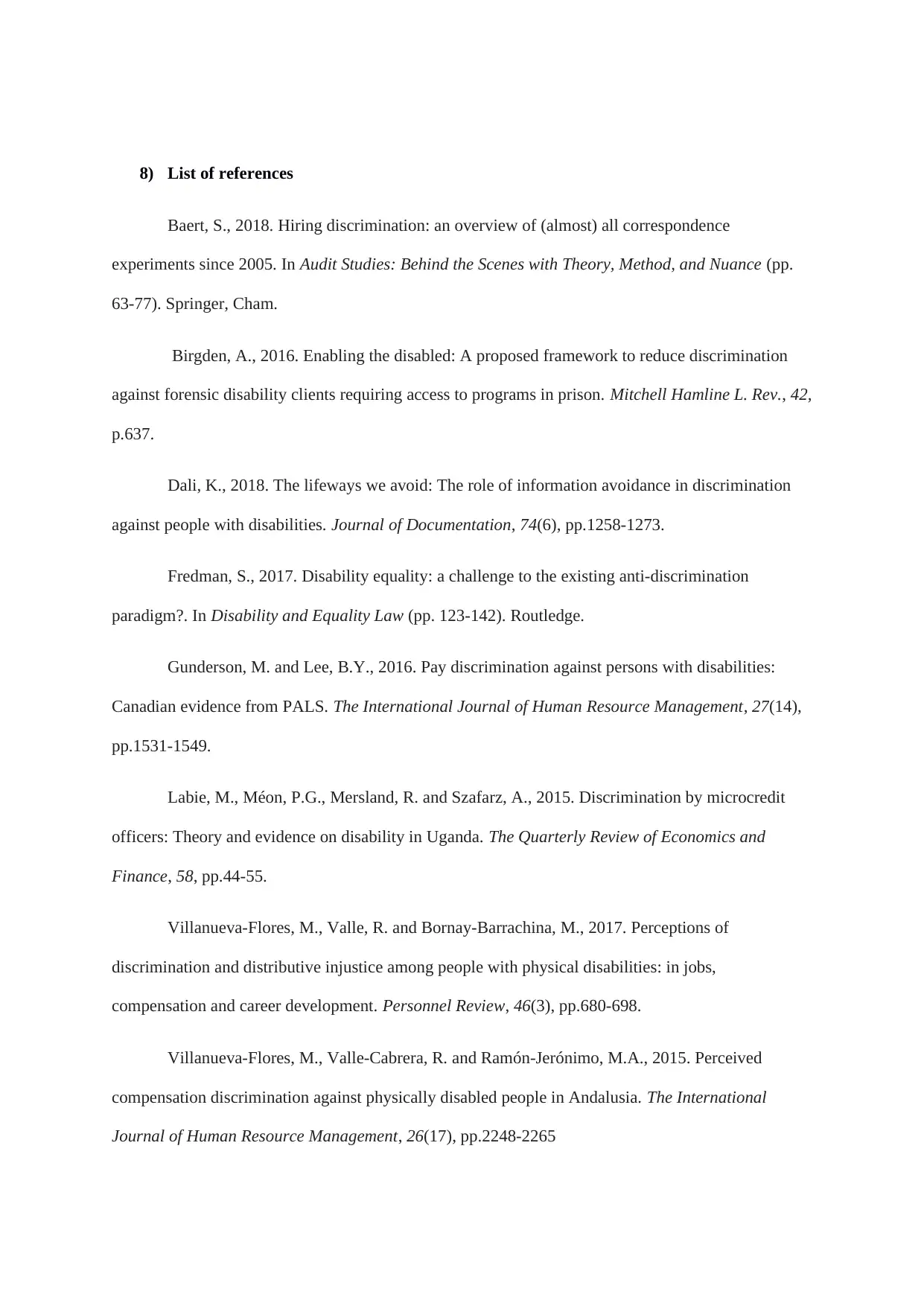
8) List of references
Baert, S., 2018. Hiring discrimination: an overview of (almost) all correspondence
experiments since 2005. In Audit Studies: Behind the Scenes with Theory, Method, and Nuance (pp.
63-77). Springer, Cham.
Birgden, A., 2016. Enabling the disabled: A proposed framework to reduce discrimination
against forensic disability clients requiring access to programs in prison. Mitchell Hamline L. Rev., 42,
p.637.
Dali, K., 2018. The lifeways we avoid: The role of information avoidance in discrimination
against people with disabilities. Journal of Documentation, 74(6), pp.1258-1273.
Fredman, S., 2017. Disability equality: a challenge to the existing anti-discrimination
paradigm?. In Disability and Equality Law (pp. 123-142). Routledge.
Gunderson, M. and Lee, B.Y., 2016. Pay discrimination against persons with disabilities:
Canadian evidence from PALS. The International Journal of Human Resource Management, 27(14),
pp.1531-1549.
Labie, M., Méon, P.G., Mersland, R. and Szafarz, A., 2015. Discrimination by microcredit
officers: Theory and evidence on disability in Uganda. The Quarterly Review of Economics and
Finance, 58, pp.44-55.
Villanueva-Flores, M., Valle, R. and Bornay-Barrachina, M., 2017. Perceptions of
discrimination and distributive injustice among people with physical disabilities: in jobs,
compensation and career development. Personnel Review, 46(3), pp.680-698.
Villanueva-Flores, M., Valle-Cabrera, R. and Ramón-Jerónimo, M.A., 2015. Perceived
compensation discrimination against physically disabled people in Andalusia. The International
Journal of Human Resource Management, 26(17), pp.2248-2265
Baert, S., 2018. Hiring discrimination: an overview of (almost) all correspondence
experiments since 2005. In Audit Studies: Behind the Scenes with Theory, Method, and Nuance (pp.
63-77). Springer, Cham.
Birgden, A., 2016. Enabling the disabled: A proposed framework to reduce discrimination
against forensic disability clients requiring access to programs in prison. Mitchell Hamline L. Rev., 42,
p.637.
Dali, K., 2018. The lifeways we avoid: The role of information avoidance in discrimination
against people with disabilities. Journal of Documentation, 74(6), pp.1258-1273.
Fredman, S., 2017. Disability equality: a challenge to the existing anti-discrimination
paradigm?. In Disability and Equality Law (pp. 123-142). Routledge.
Gunderson, M. and Lee, B.Y., 2016. Pay discrimination against persons with disabilities:
Canadian evidence from PALS. The International Journal of Human Resource Management, 27(14),
pp.1531-1549.
Labie, M., Méon, P.G., Mersland, R. and Szafarz, A., 2015. Discrimination by microcredit
officers: Theory and evidence on disability in Uganda. The Quarterly Review of Economics and
Finance, 58, pp.44-55.
Villanueva-Flores, M., Valle, R. and Bornay-Barrachina, M., 2017. Perceptions of
discrimination and distributive injustice among people with physical disabilities: in jobs,
compensation and career development. Personnel Review, 46(3), pp.680-698.
Villanueva-Flores, M., Valle-Cabrera, R. and Ramón-Jerónimo, M.A., 2015. Perceived
compensation discrimination against physically disabled people in Andalusia. The International
Journal of Human Resource Management, 26(17), pp.2248-2265
⊘ This is a preview!⊘
Do you want full access?
Subscribe today to unlock all pages.

Trusted by 1+ million students worldwide
1 out of 6
Related Documents
Your All-in-One AI-Powered Toolkit for Academic Success.
+13062052269
info@desklib.com
Available 24*7 on WhatsApp / Email
![[object Object]](/_next/static/media/star-bottom.7253800d.svg)
Unlock your academic potential
Copyright © 2020–2025 A2Z Services. All Rights Reserved. Developed and managed by ZUCOL.





